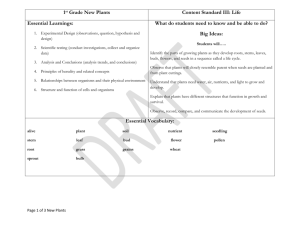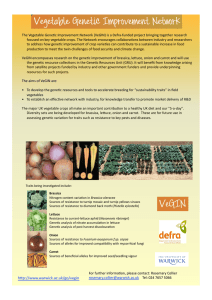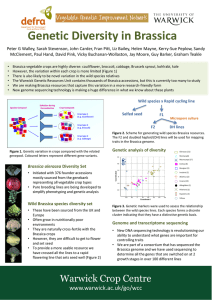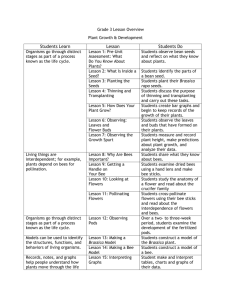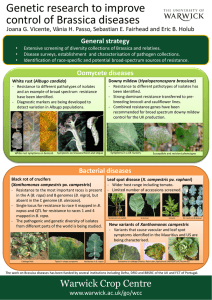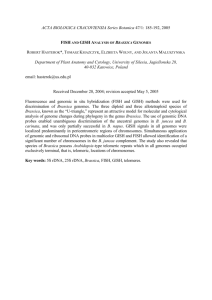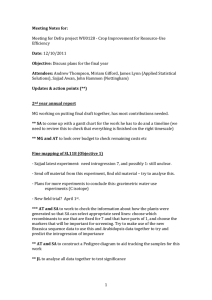Lesson 3: Life Cycle of Brassica Plants Part II: Observing Growth
advertisement
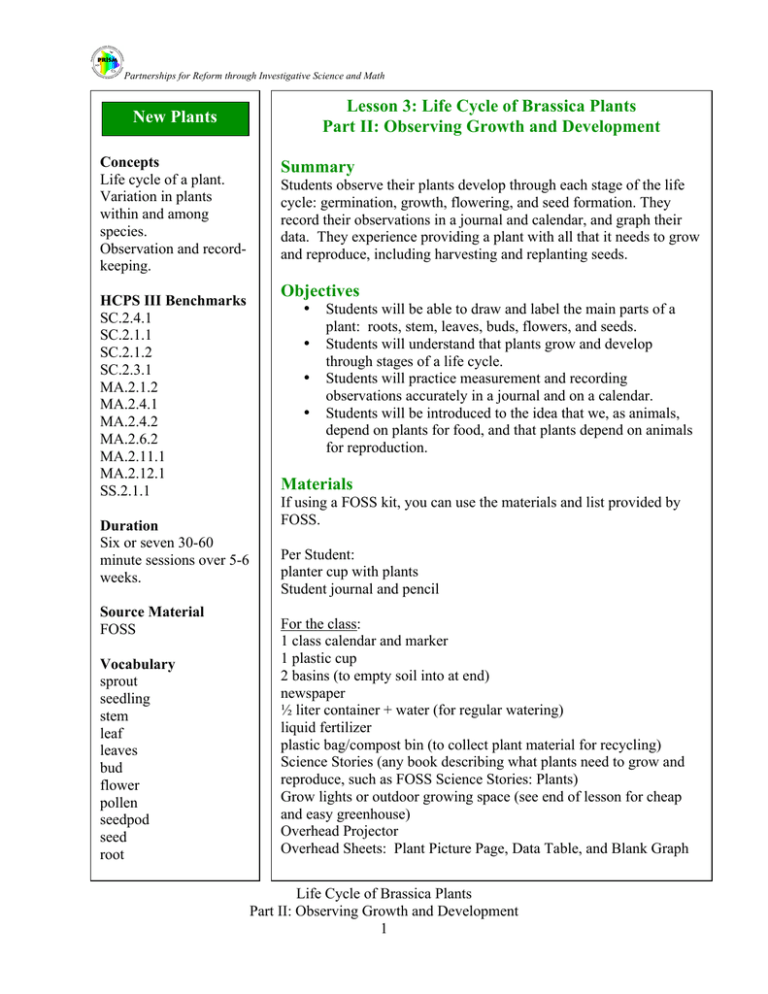
Partnerships for Reform through Investigative Science and Math Lesson 3: Life Cycle of Brassica Plants Part II: Observing Growth and Development New Plants Concepts Life cycle of a plant. Variation in plants within and among species. Observation and recordkeeping. HCPS III Benchmarks SC.2.4.1 SC.2.1.1 SC.2.1.2 SC.2.3.1 MA.2.1.2 MA.2.4.1 MA.2.4.2 MA.2.6.2 MA.2.11.1 MA.2.12.1 SS.2.1.1 Duration Six or seven 30-60 minute sessions over 5-6 weeks. Source Material FOSS Vocabulary sprout seedling stem leaf leaves bud flower pollen seedpod seed root Summary Students observe their plants develop through each stage of the life cycle: germination, growth, flowering, and seed formation. They record their observations in a journal and calendar, and graph their data. They experience providing a plant with all that it needs to grow and reproduce, including harvesting and replanting seeds. Objectives • • • • Students will be able to draw and label the main parts of a plant: roots, stem, leaves, buds, flowers, and seeds. Students will understand that plants grow and develop through stages of a life cycle. Students will practice measurement and recording observations accurately in a journal and on a calendar. Students will be introduced to the idea that we, as animals, depend on plants for food, and that plants depend on animals for reproduction. Materials If using a FOSS kit, you can use the materials and list provided by FOSS. Per Student: planter cup with plants Student journal and pencil For the class: 1 class calendar and marker 1 plastic cup 2 basins (to empty soil into at end) newspaper ! liter container + water (for regular watering) liquid fertilizer plastic bag/compost bin (to collect plant material for recycling) Science Stories (any book describing what plants need to grow and reproduce, such as FOSS Science Stories: Plants) Grow lights or outdoor growing space (see end of lesson for cheap and easy greenhouse) Overhead Projector Overhead Sheets: Plant Picture Page, Data Table, and Blank Graph Life Cycle of Brassica Plants Part II: Observing Growth and Development 1 Partnerships for Reform through Investigative Science and Math Making Connections Students may be able to name different kinds of green vegetables in the brassica family (see background). Many of these “greens” were first brought to Hawaii by Chinese plantation workers, who grew much of their own food in home gardens. The Farmer’s Market Connection homework assignment will be assigned once the students have had a chance to get to know their plants a bit. During the introductory discussion, students may have suggested ways to grow new plants, primarily, from seeds. Students now may be able to name most of the things plants need to grow, and can be allowed to direct this activity as much as possible. Teacher Prep for Activity 1. SCHEDULE THE INVESTIGATION. Observations will take four or five sessions of about 20-30 minutes, spaced over 4-5 weeks, as the plants develop through each stage of growth. Plan on about an hour for the first session, in which you will take more time modeling proper recording of observations, and an hour for the pollination session (Session 4). Keeping a detailed calendar from the first year will help you schedule the activity more accurately in future years. During this time the kuleana (responsibility) for watering the brassica plants will rotate from group to group. Do not over-water the plants! 2. PLAN ASSESSMENT: STUDENT JOURNAL. Once a week or so, students will record changes to their plants in their student journals. Each plant picture page has an identical drawing on each half, with room for observations. Students can write basic observations about their plants, and add a sentence about how they are changing. If students include information about the emerging plant structures that reflects reality, and demonstrates understanding of the name and function of each plant part as it emerges, they are right on target. You may, however, be able to identify students who need to work on distinguishing between recording true observations of, and ideas about, plants and plant parts. 3. COPY THE PLANT PICTURE PAGE ONTO OVERHEAD PROJECTOR SHEET. You will use this to demonstrate how to record observations. 4. THINK ABOUT PART 2. This part describes a series of observations, discussions, and recording sessions. Each suggested discussion should take place after students have made their own observations or have discovered something interesting like a new leaf, buds, or seedpods. 5. RAISING THE LAMP: As the brassica plants grow, it will be necessary to raise the lamp to maintain a distance of 3-7 cm (1-3”) between the light bulbs and the tops of the plants. When raising the lamp, support it with one hand while readjusting the chains. This will prevent damage to the plants and lamp should the chain slip between your fingers (it’s a bit tricky). Ask a student to help. 6. THINK ABOUT MEASURING GROWTH. Have the students measure the plants every few days, and record their measurements in the data sheet. Data collected in this way will be used to draw a line graph (scatter plot). Alternatively, students may graph only the ultimate height Life Cycle of Brassica Plants Part II: Observing Growth and Development 2 Partnerships for Reform through Investigative Science and Math reached by each of the two types of plants. This would be a bar graph. A blank data sheet and graph axes can be found at the end of this lesson. Please refer to the graphing lesson for tips or help. 7. READ A SCIENCE STORY ON WHAT PLANTS NEED: Plan to read a science story about what plants need during the first week of the investigation. Any non-fiction book from the children’s section of your library will do—choose something simple, and easy to read aloud, that focuses specifically on what people and nature provide to growing plants, and why. Avoid books with lots of distracting insets and labels. Background Brassica grows best when it is kept moist and well fertilized. To do this, put water in the tray in which the planter cups stand. The water will soak up into the cups. Add water only after all of the water has been soaked up (or evaporated). At that time add liquid fertilizer to ! liter of water (or amount needed to cover holes in bottom of cups) and pour it into the tray. The light that shines on the brassica plants should be as intense as possible, for the fastest progression. If you will be keeping the plants indoors, you absolutely must use grow lights, and keep them within 3 and 7 cm from the top of the plants for maximum growth. If you will be growing plants outdoors, be sure they will receive direct sunlight from dawn to dusk. Placing them just outside a building will generally block their sunlight for half the day, and the life cycle will not be completed in a reasonable amount of time. Finding Pollinators (For flower observation activity): Bees love the flowers of palms and kiawe, any “powder-puff” shaped flowers, or any big patch of bright flowers. Butterflies visit many of the brightly colored honey-suckle shaped flowers you might see on school campuses. If there is a school garden, of course--go there! Bird and bat pollinators are hard to catch in the act in towns, though Japanese White Eyes might be spotted gleaning insects from flowering or fruit trees. Life Cycle of Brassica Plants Part II: Observing Growth and Development 3 Partnerships for Reform through Investigative Science and Math Procedure 1. LOOK FOR GROWTH The first sprouts will appear in about 2 days, and they will grow and develop rapidly for 4 weeks. Groups should take turns watering as necessary and recommending when the lamp should be raised. Encourage students to observe informally every day. They should periodically make systematic observations and record and measure the changes they see in their student journals. Use the class calendar to note the dates of important events. As the plants grow, have a discussion at the rug from time to time. Focus student observations on different parts of the plants as they emerge. Discuss how plants function (ex. roots take up water and minerals from the soil, stems hold up the plant, leaves capture light and produce food, flowers produce seeds, seeds produce new plants). Additional questions to guide the discussion are suggested below. SESSION 1: OBSERVING SPROUTS (one hour). 1. DISCUSS PLANT GROWTH On the day that each plant has emerged in every cup, have students observe their planters. Gather students at the rug to discuss what they have noticed. You might ask, • What do you observe in your planters? • What colors do you see on each of your plants? • What words are used to describe baby plants? [sprouts, seedlings]. • Are all of the plants the same size? Why do you think this is the case? • What questions do you have about your plants? • Did all of the seeds sprout? Why? [some of the seeds weren’t alive, some will sprout later] 2. MODEL RECORDING OBSERVATIONS IN JOURNALS Explain that scientists keep drawings and descriptions about the plants they study. Tell students, that their science journals are for recording what they observe. They should write down every change they see in their planters. [New leaves, changes in height, color] Place an overhead of the plant picture page on your overhead projector. Using students’ suggestions, draw how the planter cups look with their new sprouts. Ask individual students to focus on some details, including: • How many sprouts are in the cup? • What color are the sprouts? • How big should I draw the sprouts? • How many days has it been since we planted the seeds? • Is there anything else I should add to my drawing? Captions are an important part of the recording process. Model this process, using students’ suggestions. Life Cycle of Brassica Plants Part II: Observing Growth and Development 4 Partnerships for Reform through Investigative Science and Math Remove or erase your plant picture page before students make their own recording, so they will look at their actual plant. 3. MODEL MEASURING AND RECORDING IN A DATA TABLE Hold up a ruler, and point out the centimeters, and the zero-end. Gently place the correct end of the ruler against the soil, and measure the height of the plant at its highest point (don’t worry if it is a leaf tip, stem, or flower, the highest point is the simplest to measure). Draw or project Brassica Plants data table onto the board. Point out the columns for day and height for each type of plant. Show how too clearly and accurately record the height of each plant, rounding to the nearest centimeter. 4. RECORD IN STUDENT JOURNALS Have students return to their seats with their plants to make entries in their journals. The plant picture entry should include a drawing, the number of days that have elapsed since planting, and a caption or comment related to the observation. The data table entry should include the number of days since planting, and the heights of both types of plants (just the tallest, if two plants per cup). If students are writers, let them caption each drawing independently. If they need help, let them dictate to an adult or other student. 5. READ A SCIENCE STORY ON WHAT PLANTS NEED: (Either at the end of the session or any time this week). Any non-fiction book for children from the plants section of your local library will do. Choose one that is simple and good for reading aloud, without lots of distracting insets and labels. The idea is just to review some of the things you are providing for your plants, and why. BREAKPOINT Life Cycle of Brassica Plants Part II: Observing Growth and Development 5 Partnerships for Reform through Investigative Science and Math SESSION 2: OBSERVING LEAF GROWTH 1. DISCUSS LEAVES When all of the planters have new leaf growth, gather students at the rug for a group discussion of what they have noticed. You may want to ask questions from the list below. • • • • • • • What has changed since you last observed your planter? What colors do you see on your brassica plants? Where are the leaves growing? Are they all the same? What do you suppose leaves do for the plant? [they capture light to make food] Are there any experiments we could do to see if leaves really make food for the plants? Are all of the brassica plants the same size? Why do you think that is the case? Do you predict that the smallest ones will catch up or stay small? 2. MODEL RECORDING IN JOURNALS Discuss observation of plants with students. As the teacher models drawing in his or her plant picture page, some possible focus questions might be: • How many leaves are on one plant? • What color are the leaves? • What shapes are the leaves? • Where on the plant do they grow? [on the stem] • Is each leaf even with another leaf or higher up on the stem? (opposite or alternating) • How many days has it been since we planted the seeds? • Is there anything else I should add to my drawing? • What questions do you have about your brassica plants? Add captions suggested by students and make sure the days of growth have been added to the data table. Erase your model before the students draw their own plant. 3. RECORD IN STUDENT JOURNALS Have students return to their seats with their plants to make entries in their own journals, as before. BREAKPOINT Life Cycle of Brassica Plants Part II: Observing Growth and Development 6 Partnerships for Reform through Investigative Science and Math SESSION 3: OBSERVING FLOWER GROWTH (20 min) 1. DISCUSS PLANT GROWTH When the first buds appear, focus attention to the budding flowers, but don’t feel the need to instruct the students about what the flowers do for the plants—they will discover this information as they watch the seed pods develop. 2. MODEL RECORDING IN JOURNALS Depending on the students’ experience, you might model recording with the class or have the students record independently in their journals. 3. RECORD IN STUDENT JOURNALS Have students return to their seats with their plants to make entries in their own journals, as before. BREAKPOINT Life Cycle of Brassica Plants Part II: Observing Growth and Development 7 Partnerships for Reform through Investigative Science and Math SESSION 4: BIRDS, BEES, AND BUTTERFLIES (60 min)**ALLERGY ALERT!!** 1. TAKE A WALK OUTDOORS a. On a day when many of the plants have several open flowers b. Take students, journals in hand, to a spot outside where they can observe some flowers and, hopefully, pollinators in action. 2. OBSERVE a. Arrange students where they can safely and quietly observe the flowers and look for insects. b. Ask them to silently watch for a few minutes, without talking or recording anything. Then have a quiet discussion: • What do you see here? • Are there any living things here besides plants? • What are the insects doing? [flying, landing, crawling] • Why are they doing these things? [to pollinate the flowers? (no!) to get nectar? (right! bees don’t pollinate the flowers on purpose—they just want the nectar and pollen for food]. • Can you observe any pollen on the insects? How about the flowers? How about nectar? If you can’t see nectar, can you use one of your other senses to observe whether or not nectar is in there? • Is there nectar in a dead flower? 3. RECORD OBSERVATIONS a. If it is safe, have the students examine the flowers up close. b. Have the students draw or write what they see insects doing (disappearing into flowers and then coming out again), c. and what they infer (predict, guess) they are actually doing inside (getting nectar to take back to the hive). 4. DISCUSS POLLINATING AND BRASSICA a. Return to the classroom b. Explain that brassica plants will only produce healthy (viable) seeds if they receive pollen from another plant. c. Select a reserve plant or volunteers to remain unpollinated. d. Let students be the pollinators. a. Bump the flower heads from two plants gently together several times. b. Or use a Q-tip to transfer the pollen (more like a bee or butterfly). c. Repeat: Since the anthers and pistils (male and female parts) are mature at different times, it’s a good idea to repeat this process every day or two during peak flowering. d. Don’t worry about teaching the whole process of pollination and fertilization right now—just provide awareness. BREAKPOINT Life Cycle of Brassica Plants Part II: Observing Growth and Development 8 Partnerships for Reform through Investigative Science and Math SESSION 6: HARVESTING THE SEEDS 1. ALLOW THE PLANTS TO DRY a. The seedpods will look like tiny string beans. As soon as they are filled out, stop watering the plants and let them dry out and die. b. You can explain to the children that the plants will naturally die after the seeds are produced, whether you water them or not. c. When the pods are tan and brittle (about 2 weeks after you stop watering) you can pick the pods. d. Don’t forget to keep measuring the plants—do they shrink when they dry out? Note: If the plants are getting large without producing a flower stalk, water them less, or you may want to transfer the plants to a garden. Bok choy likes full sun, but if you are planning to eat it, it must be watered everyday, or the plant becomes bitter. Once the plant fills out into a nice rosette, it is ready to eat, but if flowers are allowed to develop, to complete this investigation, the leaves change shape and become tough and bitter. 2. HARVEST THE SEEDS a. Have the students pick the pods gently off of their dry plants, and observe the seeds inside. b. Count the seeds in each pod, and record observations in their journals. c. Tape a few seeds in their journals, and plant one or two in a new planter cup, confirming the life-cycle. d. Call attention to the fact that each plant made many seeds with which to replace itself. Why is that? [in case some get damaged, eaten, or never make it to a good place to grow] 3. RECYCLE THE SOIL a. Have groups come up one at a time to pull up their plants and recycle the potting soil by crumbling it into a basin. b. Call attention to the roots of the plants as they do this. The soil can be re-used in a future investigation. c. Remove stickers from their cups, rinse and stack them. BREAKPOINT Life Cycle of Brassica Plants Part II: Observing Growth and Development 9 Partnerships for Reform through Investigative Science and Math WRAP-UP! 1. CHART THE GROWTH OF THE PLANTS a. Explain to the class that scientists use charts, also called graphs, to help explain the results of their studies. A graph is a way to “see” how our plants grew over time. b. Make the graph together: Have students open their journals to their brassica growth data table. c. Give each student a blank graph worksheet. d. On an overhead, point out all the parts of the graph, including the y-axis (height, in cm) and the x-axis (time, in days). e. Show how you can line up the numbers on the two axes at a cross point, which is a data point. f. Plot only one plant at a time. This will take awhile if it is the student’s first experience with graphing. It is actually much easier to do this on Excel with young students (see Graphing Tutorial for help). . 12. MAKE WORD BANK ENTRIES A suggestion of new words to add to the class word bank as you go: • sprout • seedling • stem • leaves/leaf • bud • flower • pollen • seedpod • seed • root 13. MAKE CONTENT CHART/KWL ENTRIES If using a concept chart or Know/Want to know/Learned chart, make entries. • How does a new brassica plant start? • In what order do the new plant parts grow? • What did we do to the classroom plants that bees would do in nature? • What other questions do you have about your brassica plants? Again, just be sure to include a KWL chart for the students to write on or give instructions for teacher to make out of chart paper. Life Cycle of Brassica Plants Part II: Observing Growth and Development 10 Partnerships for Reform through Investigative Science and Math Assessments Plant Picture Pages: These should reflect realistic, accurate observations, use of vocabulary words, and a demonstrated understanding of the function of each emerging plant part. Calendar: This should accurately show when each new plant part emerged, as well as any interesting developments. Resources FOSS New Plants Program Corum, Ann Kondo. 2000. Ethnic Foods of Hawaii, revised ed. Bess Press, Honolulu. Oshiro, Kathy. Growing Vegetables in Hawaii. Bess Press, Honolulu. This book examines the plants that do well in Hawaii as well as how to properly grow them. Oshiro also includes recipes and nutritional information for each plant. Handy, E.S. Craighill and Elizabeth Green Handy. 1991. Native planters in old Hawaii : their life, lore, and environment /; with the collaboration of Mary Kawena Pukui. Bishop Museum Press, Honolulu. Consult any gardening book for help on basic gardening. Hydroponics books are very helpful on lighting and fertilization. Hydroponic store-owners are often very generous with loaning equipment and lots of free advice! Mahalo to Hilo’s Ohana Greenhouse Supply on Lanikaula St. for loaning the grow lights and other hydroponic equipment used to test activities for this unit! Extension Activities FARMER’S MARKET CONNECTION: (worksheet below). Students are asked to take a checkoff sheet with them to a farmer’s market or grocery and check off all the brassica family plants they can find, then tell the class if they brought any home to eat. ROADSIDE BRASSICA: Everywhere you go in Waikoloa, cheerful yellow flowers wave along the roadside. These are Indian Mustard, or wild mustard, and are another brassica plant! Look for them as you drive the upper road to Kona! (Wikipedia: Indian mustard, brassica and a lovely picture will come up). PLANT YOUR BRASSICA HARVEST: Plant the seeds the students picked from their old plants. Discuss this life cycle and ask students to suggest other kinds of life cycles they know about. LABEL THE PLANT PARTS: Using the Plant Parts worksheet, ask students to label all the parts of the plants that they observed during this investigation, and tell what each part’s “job” is. FORM AND FUNCTION: Go to www.understandingevolution.org and do the Form and Function Activity. In this activity, groups of students go to several different stations, each with an organism with a unique adaptation. The students come up with hypotheses about what the adaptation is for. Life Cycle of Brassica Plants Part II: Observing Growth and Development 11 Partnerships for Reform through Investigative Science and Math Name Date FARMER’S MARKET CONNECTION Aloha, In class we are growing green vegetables known as brassica plants. The brassica family of plants includes many that we eat or see at the market. These green, leafy vegetables and their giant flower heads are grown all over the Big Island, in large, commercial operations, and on small organic farms. The next time you are at a farmer’s market or grocery with your child, please take this checklist and a pencil with you. Ask your child to check off any of the following brassica plants that you find together. bok choy broccoli brussels sprouts cauliflower pak choy chinese mustard collard greens kale kohlrabi red cabbage turnips white cabbage Any others? __________ Any questions? Did you bring any home to eat? Tell us about it in class. Life Cycle of Brassica Plants Part II: Observing Growth and Development 12 Partnerships for Reform through Investigative Science and Math Bok Choy Life Cycle Calendar Sunday Monday Tuesday Wednesday Thursday Life Cycle of Brassica Plants Part II: Observing Growth and Development 13 Friday Saturday Partnerships for Reform through Investigative Science and Math Brassica Life Cycle Calendar Sunday Monday Tuesday Wednesday Thursday Life Cycle of Brassica Plants Part II: Observing Growth and Development 14 Friday Saturday Partnerships for Reform through Investigative Science and Math Name Date Growth of Brassica and Bok Choy Count the number of days since you planted your seeds and record in the first column. Carefully measure and record the heights of your brassica and bok choy plants. Write interesting changes like "flowers open" in the Notes column. # Days Height Brassica (cm) Height BokChoy (cm) Life Cycle of Brassica Plants Part II: Observing Growth and Development 15 Notes Partnerships for Reform through Investigative Science and Math Life Cycle of Brassica Plants Part II: Observing Growth and Development 16 Partnerships for Reform through Investigative Science and Math Plant Picture Page Name: Day :::: Day :: Life Cycle of Brassica Plants Part II: Observing Growth and Development 17 Partnerships for Reform through Investigative Science and Math Bok Choy Life Cycle Calendar Sunday Monday Tuesday Wednesday Thursday Life Cycle of Brassica Plants Part II: Observing Growth and Development 13 Friday Saturday Partnerships for Reform through Investigative Science and Math Brassica Life Cycle Calendar Sunday Monday Tuesday Wednesday Thursday Life Cycle of Brassica Plants Part II: Observing Growth and Development 14 Friday Saturday Partnerships for Reform through Investigative Science and Math Name Date Growth of Brassica and Bok Choy Count the number of days since you planted your seeds and record in the first column. Carefully measure and record the heights of your brassica and bok choy plants. Write interesting changes like "flowers open" in the Notes column. # Days Height Brassica (cm) Height BokChoy (cm) Life Cycle of Brassica Plants Part II: Observing Growth and Development 15 Notes Partnerships for Reform through Investigative Science and Math Life Cycle of Brassica Plants Part II: Observing Growth and Development 16 Partnerships for Reform through Investigative Science and Math Plant Picture Page Name: Day :::: Day :: Life Cycle of Brassica Plants Part II: Observing Growth and Development 17

